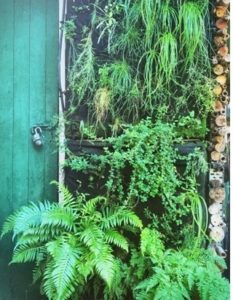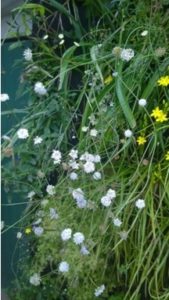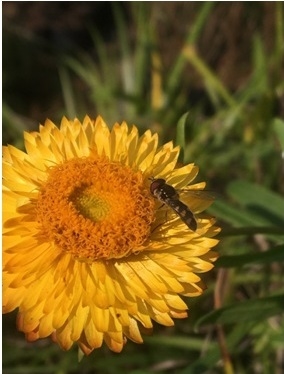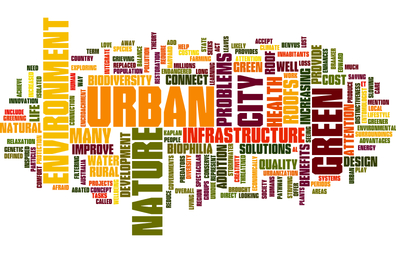More people are becoming interested in using Native Australian plants for Green Roofs and Walls in fact, for urban greening projects in general.
We now have opportunities to enhance our urban cities of high rise buildings and flat roof tops – and make our cities sustainable, by using them as the basis for green space.
Green infrastructure increases ecosystem functions in our cities, also making them more visually pleasing and more livable.
Nature has created green walls and it’s from nature that we get our inspiration.
Many southern facing sandstone walls all over the eastern side of Australia are covered with ferns, such as:
- Gleichana (Coral fern)
- Adiantum (Maidenhair Fern)
- Todea barbara (King Fern).
Many forest figs, on the high branches, have native orchids, such as, Denbrobiums, Sarcochillis and fern species such as Microsorum and Pyrrosia (Rock fern), growing on them.
They look magnificent.
What are the Functions of Green Roofs and Walls?
Green roofs and walls are an opportunity for the promotion of our beautiful, unusual and highly adaptive native plants species!
A celebration of the complexities and uniqueness of the natural world in our bushland.
The Sydney bioregion has an amazing range of species easily out numbering all of Europe.
What better way to showcase these species than the use of green walls, providing a connection to green spaces and natural beauty, while enhancing biodiversity and preserving rare species in our urban environments?
This connection is also a way to educate the next generation on the importance of sustaining current native Australian plant species- and its benefit to our people and cities.
Health and wellbeing can also be enhanced through the use of green spaces such as green walls and roofs
Connection with green spaces make us feel good, purifying the air around us, and promoting good mental health in the community.

The collection of water in a green roof or wall slows down the rate of storm water discharge. Many cities can be crippled with flash flooding and essential services halted, therefore storm water retention is a positive aspect that can be introduced by green walls and roofs.
As cities become bigger they get noisier and congested with more traffic and people.
Overhead aircraft make conversation impossible to hear.
The insulating nature of plants and the greenwall systems itself will help to absorb this noise
A quieter environment makes people more productive and lessens the factors that escalate stress and sickness.
A building will have energy saving aspects with the insulation of a green wall or roof, protecting the building from heat, therefore reducing the cost of cooling.Food Production on a roof or wall again brings closer the connection we have with the very source of our nutrition and health.
This connection is being lost at the fast food mall or urban ‘feedlot’ where food is churned out and does not reflect the product produced in the paddock, or ground.
Patrick Blanc, a French botanist, started the green wall movement in Europe, with a system of growing plants that was inspired by an interest in terrariums.
Patrick’s green walls are a work of art, showcasing the function and beauty of green spaces in our urban dwellings.
Patrick’s green walls have migrated to Australia, and examples can be seen at the Central Park Building, located in Broadway, Sydney.
Utilising a felt wall design, the plants are planted into a felt material, irrigated and fertilised.
This is great for regions with low evaporation rates and where water is abundant
Other systems have pots on a wall approach or a vegetative bag combining the felt and a potting media.
When extra media is applied to a system it reduces the risk of an irrigation failure or temperature stress.
The type of green wall system will determine the plants that are suitable on the green wall or rooftop
It is important to get the right plants on the wall and roof, species that are able to cope with the medium used and the local environment.
It is important to stress that Australia’s low moisture and high temperatures are a major hurdle to the success of green infrastructure.
To overcome the challenges of the Australian environment, the vegetative bag, green wall designs allow for a larger volume of growing media to be accessed and a greater chance of survival.
- Our native plants have adapted themselves to these conditions and have developed strategies and adaptations to survive.
- Fleshy thickened leaves are able to store water; this is a characteristic of succulence in leaf morphology (Dendrobiums).
- The roots of many local native plants have adaptations to store water, for example fleshy roots or water storing bulbs (Bulbine, Arthropodium).
- Dormancy is a characteristic in dry land species where the plant shuts down until adequate moisture is available and re-sprouting is a mechanism for recovery after drought.
Another category for plant selection is flowers, a green installment has to present well and be aesthetically pleasing for those working and living within the area/building.
Meadow gardens in Europe are making a name for themselves and are showcased at garden festivals.
Many local native meadow species include a mix of flowering and grass like plants, excellent choices for a green wall.
Ferns are very successful on green walls,sometimes too successful and can take over.
They are an excellent choice for a wall located in shade, and can be used on the lower part of a green wall where there is abundant moisture.
Bringing diversity to a garden is a great way to enjoy the many visitors that migrate from day to day or season to season
Its the pollinators like bees that are in decline due to climatic changes and chemical pollution.
Pollinators need flowers to attract them, they are an important aspect of green wall development and ecosystem functions.
Native meadow plants that I have found valuable are:
- Trachymene incisa (Native Parsnip)
- Brunoniella (Blue trumpet)
- Wahlenbergia (Native Bluebells)
- Dicopogon (Chocolate lily).
Every green space is different due to location and climate and it is essential that species be trialed to determine the right plants for your green wall or roof.
Don’t be afraid to try different species out as you might be surprised at their ability to thrive in differing conditions!
It is an exciting time to be working in the field of our Australian Native plants as they are well suited to to the challenges of integrating nature with infrastructure.
